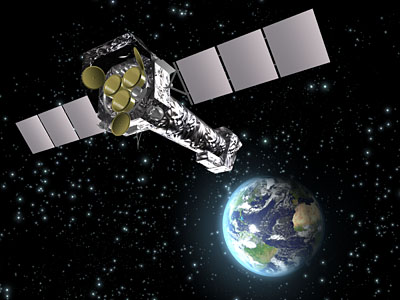For the first time, a spacecraft has detected signals from both stars of a binary pulsar system in X-rays. XMM-Newton is watching both stars radiate pulsating X-rays, providing scientist with the perfect laboratory for high energy physics and a never-ending source of intriguing physical problems. The binary pulsar PSR J0737-3039 was first spotted by astronomers in 2003 in radio wavelengths, but now X-rays can be used to investigate this system in greater detail.
Binary pulsars are extremely rare. Each star of the closely-packed system is a dense neutron star, spinning extremely fast, radiating X-rays in pulses. One pulsar (B) rotates slowly, what scientists call a ‘lazy’ neutron star, while orbiting a faster and more energetic companion (pulsar A).
Each pulsar or neutron star once existed as a massive star. “These stars are so dense that one cup of neutron star-stuff would outweigh Mt. Everest,†says Alberto Pellizzoni, who has been studying this system. “Add to that the fact that the two stars are orbiting really close to each other, separated by only 3 light-seconds, about three times the distance between Earth and the Moon.â€
Pellizzoni added, “One cup of neutron star-stuff would outweigh Mt. Everest. Add to that the fact that they’re orbiting really close, separated by only about three times the distance between Earth and the Moon.â€
Pulsar B is an oddity, in that it is very different from a ‘normal’ pulsar. Additionally, the amount of X-rays coming from the system is greater that the scientists predicted. But how the two pulsars work together is still not understood.
“One possible solution for the mystery could be mutual interaction between the two stars, where the lazy star derives energy from the other,†says Pellizzoni.
Watch video of how the two pulsars may interact
The fundamental physical processes involved in these extreme interactions are a matter of debate among theoretical physicists. But now, with XMM-Newton’s observations, scientists have gained new insight, providing a new experimental setting for them. In X-rays, it will be possible to study the subsurface and magnetospheres of the stars as well as the interaction between the two in that close, heated environment.
This system also provides the study of strong-field gravity, given how close and dense the two stars are. Future tests of general relativity by radio observations of this system will supersede the best Solar System tests available. It is also a unique laboratory for studies in several other fields, ranging from the equation of state of super-dense matter to magneto-hydro dynamics.
Original News Source: ESA


Do we get polarization of the beams? They might be passing through each other’s magnetic fields. That might show up in xrays.
Cool video.
It bothers me a little when a 2003 story is “the first time ever”. OK, so it’s a followup story, and that’s really cool. But it would cooler still to say that this is a followup. It’s not the first observation, just the first from a space telescope?
Wish the ESA article said more. Call the paper’s author? That’s like, work.
There seems to be annoying repetition in the article…
I hate when that happens.
Also, I hate when that happenes.
🙂